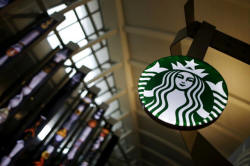Starbucks sales forecast raises questions about China,
U.S. growth
 Send a link to a friend
Send a link to a friend
 [June 20, 2018]
(Reuters) - Starbucks Corp <SBUX.O>
shares fell 4 percent on Wednesday after a dim sales forecast from the
U.S. coffee chain prompted Wall Street analysts to question the
sustainability of its growth at home and next biggest market China. [June 20, 2018]
(Reuters) - Starbucks Corp <SBUX.O>
shares fell 4 percent on Wednesday after a dim sales forecast from the
U.S. coffee chain prompted Wall Street analysts to question the
sustainability of its growth at home and next biggest market China.
Several analysts downgraded their ratings and cut their 12-month targets
on Starbucks' stock, after the company on Tuesday forecast sales growth
at established restaurants to rise by just 1 percent in the third
quarter, below Wall Street expectations of a 3 percent increase.
Starbucks also expects same-store sales in China to see no growth in the
three months ending June.
With Wednesday's decline, Starbucks' shares were on track to enter
negative territory for 2018 - a year in which well regarded Chief
Executive Officer Howard Schultz stepped down and the company found
itself at the center of an embarrassing racial profiling incident.

Morgan Stanley analyst John Glass, who downgraded the stock to
"equal-weight" from "overweight," expressed surprise at Starbucks'
expectations for China, and said the overall forecast raised questions
about the sustainability of Starbucks' growth back home. Just three
quarters ago, same-restaurant sales in China had risen 8 percent, Glass
noted.
Other analysts echoed Glass' surprise, noting that the Seattle-based
company had been upbeat about growth in China just a few weeks ago at
its investor day event, saying it was highly focused on that market.
Wells Fargo's Bonnie Herzog said the forecast for China was the most
discouraging, "putting a damper on some of the optimism we came away
with after visiting China last month."
On Tuesday, Starbucks also announced plans to close some 150 U.S. cafes
and open much fewer locations in fiscal year 2019, a result of
intensifying competition that has seen new coffee chains, convenience
stores and fast-food chains improve quality and cut prices aggressively.
[to top of second column] |

A Starbucks store is seen inside the Tom Bradley terminal at LAX
airport in Los Angeles, California, U.S. on October 27, 2015.
REUTERS/Lucy Nicholson/File Photo

Analysts also pointed to lower-than-expected same-restaurant sales in five of
the previous six quarters at Starbucks' Americas business that is dominated by
its roughly 8,000 U.S. cafes.
Some analysts said a sharper focus on digital initiatives - promoting Starbucks'
mobile app and online ordering - could make up for some of the slowdown in the
company's key markets.
"In reaction to what is now a clearer pattern of slower U.S. sales, more product
and digital innovation is in the works, but it's hard to see how much that
impacts sales," Morgan Stanley's Glass said.
Morgan Stanley's downgrade on Starbucks' shares brings the total number of
"hold" or equivalent ratings on the stock to 15. Still, 16 analysts maintain a
"buy" or higher rating.
The average Wall Street price target on Starbucks shares was $62.08. The stock
dipped 3.7 percent to $55.28 before the bell on Wednesday.
(Reporting by Nivedita Balu in Bengaluru; Editing by Sai Sachin Ravikumar)
[© 2018 Thomson Reuters. All rights
reserved.] Copyright 2018 Reuters. All rights reserved. This material may not be published,
broadcast, rewritten or redistributed.
Thompson Reuters is solely responsible for this content.
 |